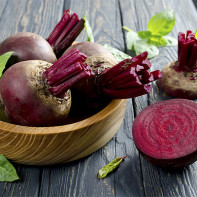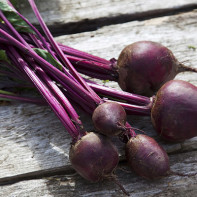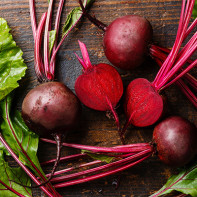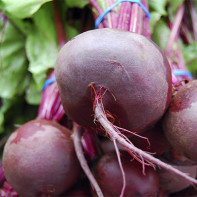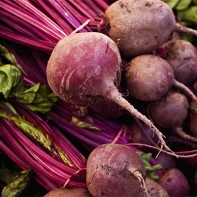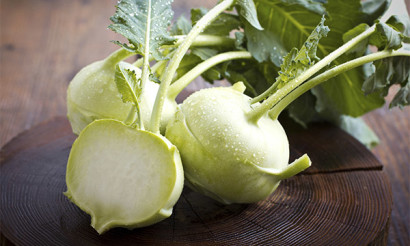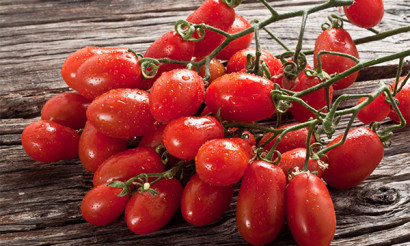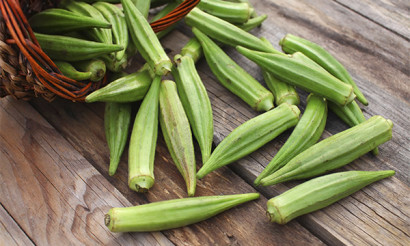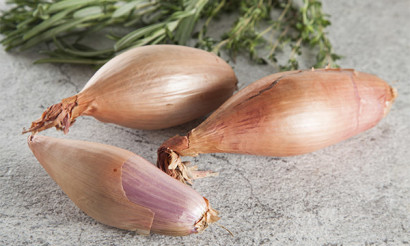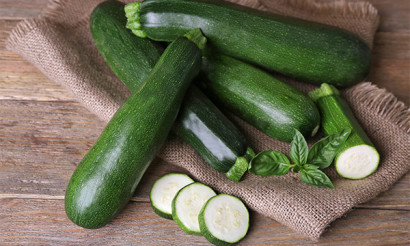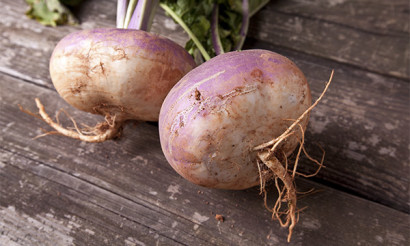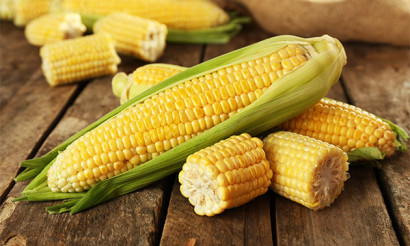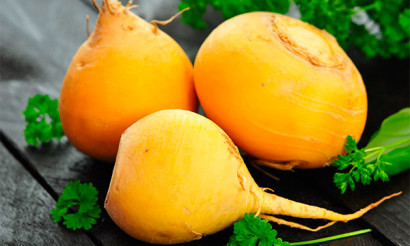Beetroot: health benefits and harms
Beginning in the 11th century, beets have been grown in Russia. Its various types are used as feed, for the production of sugar, for recipes, in cosmetology, as a raw material for therapeutic and prophylactic agents. In Belarus and Ukraine, beets are called “beetroot,” since it can take on a brown color during cooking. In Russia, the distorted Greek name "beetroot" - beets - has taken root.
- What is the difference between sugar beet and fodder
- Composition and calorie content
- Why beets are useful
- General benefit
- For women
- For men
- During pregnancy
- When breastfeeding
- For kids
- Is it possible to eat beets with weight loss
- The benefits and harms of boiled beets
- What is more useful: raw or boiled
- Useful properties of beetroot juice
- The benefits of beet kvass
- Are beet tops useful?
- Beetroot in medicine
- With diabetes
- With pancreatitis
- With gastritis
- For the intestines
- For constipation
- With gout
- With colitis
- For the liver
- With hemorrhoids
- With cholecystitis
- With anemia
- Beet-based traditional medicine recipes
- Beets in cosmetology
- For face
- For hair
- Harm and contraindications
- Beet harvesting and storage
- Is it possible to freeze
- What can be cooked from beets: recipes
- Salad
- Caviar
- Cutlets
- Phali
- Mashed potatoes
- Carpaccio
- Kvass
- Borscht
- Sauce
- Beet Chips
- How to pickle
- How to cook
- How to bake
- Is it possible to eat raw beets every day
- Can I eat at night and on an empty stomach
- Is it possible to give beets to animals
- Why after beetroot urine turns red
- Interesting facts about beets
What is the difference between sugar beet and fodder
The progenitor of all types of beets is its wild variety, originating from regions in the Far East and in India. The most popular types of beets are leaf, canteen (used in cooking), fodder and sugar.

Sugar beet is a technical crop that is grown for further processing. Ethanol, a raw material for alcohol, as well as sugar, is obtained from it. Its main difference from other species is the high sucrose content in the fruits (up to 20%), a bitter yellowish peel and bright white fruits underneath. The shape of the fruit is most often oblong.
Feed beets are high in protein, plant fiber and fiber. The most important property of this species is an increase in milk yield. Cattle enjoy eating it. If sugar beet most often reaches small sizes, a maximum of 3 kg, then feed varieties can grow up to 30 kg. The peel and fruit of the beetroot are brighter than that of sugar. Fruits can be of various shapes, round, oval. They often grow above the surface of the soil.
Composition and calorie content
100 g of ordinary table beet contains 43 kcal, 8.8 g of carbohydrates, 1.3 g of protein and 0.1 g of fat.
Vitamins:
- A (retinol) - is necessary for the health of bones, hair, skin, organs of vision. Supports the immune system.
- B1 (thiamine) - supports the brain, stimulates memory, concentration, positively affects learning, mood and appetite.
- B2 (riboflavin) - stimulates the formation of red blood cells, promotes the health of nails, hair, skin, positively affects the endocrine system.
- B5 (pantothenic acid) - stimulates the production of adrenal hormones, helping in the treatment of arthritis, colitis, allergies and diseases of the cardiovascular system, strengthens the immune system.
- B6 (pyridoxine) - supports the absorption of fats and proteins, slows down the aging process, reduces spasms, is a natural diuretic.
- B9 (folic acid) - is necessary to create new body cells, therefore it is especially important for women in the first trimester of pregnancy to get it in sufficient quantities. In addition, B9 supports the immune system, has a positive effect on heart health, hematopoietic activity.
- C (ascorbic acid) - protects the body from bacteria and viruses, stimulates the immune system, helps in healing wounds, positively affects blood vessels and heart.
- PP or B3 (niacin) - dilates blood vessels and improves blood supply to all organs, reduces the level of "bad" cholesterol.
- U - has an antihistamine effect, helps to combat the manifestation of allergies.
Minerals:
- Potassium - regulates the water content in the cells of the body, maintains a normal heartbeat, promotes brain function.
- Calcium is essential for healthy bones and teeth, has anti-inflammatory effects, and regulates the production of hormones and enzymes.
- Magnesium - supports the nervous system, muscle function, its lack can lead to kidney and stomach diseases, dizziness, insomnia, and heart problems.
- Zinc - is part of the process of bone tissue formation, positively affects the condition of the hair, stimulates mental activity, its sufficient content is the prevention of diabetes, epilepsy, arthritis and rheumatism.
- Copper - is necessary for the health of the gastrointestinal system, maintaining healthy hair and skin.
- Manganese - regulates the production and absorption of glucose, reduces blood sugar, regulates the metabolism of fats in the body, supports the health of the nervous system and the brain.
- Iron is important for the synthesis of thyroid hormones, it is necessary for the production of hemoglobin, it stimulates the absorption of B vitamins.
- Iodine - contributes to the work of the brain, positively affects the state of blood vessels, helps to absorb excess fat, supports the health of hair, nails, skin, is necessary for the thyroid gland to work.
- Boron is necessary for the endocrine system to work, it helps the absorption of calcium, magnesium and fluorine.
- Vanadium - participates in the processes of assimilation of fats and carbohydrates, helps to reduce the level of "bad" cholesterol, helps to produce cells that absorb pathogens.
- Phosphorus - supports healthy bones and teeth, provides muscle nutrition.
- Sodium - is necessary for the proper functioning of the nervous and muscle systems of the body, maintains the water-salt balance in the body, and has a vasodilating effect.
Why beets are useful
General benefit
The rich content of vitamins and minerals makes beets useful for all organs and systems of the body. It is especially important to use it for liver diseases, problems with the intestines. Beets are used not only as a satisfying and tasty product or for therapeutic and preventive purposes. It is used in cooking as a natural dye, for cosmetic purposes to maintain health and beauty. It is part of traditional medicine, which is used in the form of compresses or drops.
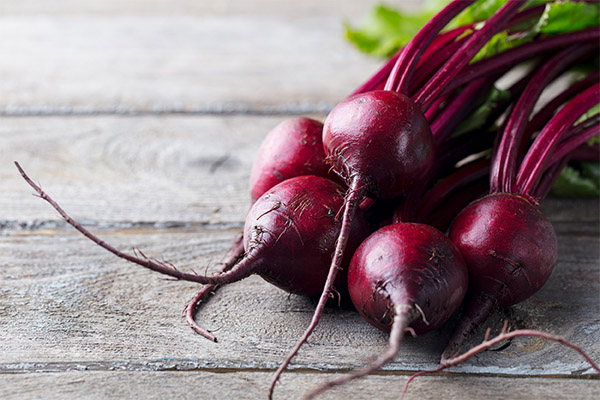
For women
Beetroot is an inexpensive and effective tool that helps to lose weight and keep fit. It regulates the metabolism, due to which toxins are eliminated from the body, and fats are broken down faster.
The use of 1-2 glasses of beetroot juice per day during the month helps to improve complexion and skin condition, balance the microflora in the gastrointestinal and reproductive systems.
Due to the content of vitamins and minerals that regulate the production of hormones and hematopoietic activity, the use of beets on critical days will help ease their course.
For men
Potassium, calcium and B vitamins stimulate the work of the muscular system, which is important for men who are engaged in physical labor or sports with heavy loads.
It is believed that due to stimulation of the cardiovascular system, vasodilation, as well as a positive effect on the central nervous system, beets have a positive effect on libido and potency.
Beets stimulate the elimination of toxins. Due to this, it is useful for men with alcohol or nicotine addiction, both with chronic use of harmful substances and during the period of refusal from them, reduces the symptoms of withdrawal.
During pregnancy
Adequate levels of folic acid in a woman’s body is a prophylaxis of birth defects of a child. Beets, rich in essential vitamins, are also recommended for pregnant women due to the fact that they help regulate the water balance and reduce swelling. Another problem that women face while expecting a baby is constipation. Beetroot is a natural laxative, with virtually no contraindications.
One of the significant restrictions for pregnant and lactating women is a reduction in the diet of raw beets and its juice. Raw fruits inhibit the absorption of calcium in the body, which is necessary for both the mother and the child. In this regard, boiled beets during the period of expectation and feeding is more preferable than raw.
When breastfeeding
Beetroot has a positive effect on the health of the mother, cleansing her body. After childbirth, women often experience anemia, so beets, rich in iron, are an important element of the diet. The complex of vitamins and minerals helps to strengthen the body, weakened by pregnancy.
Substances received in breast milk from beets do not have a negative effect on the baby, provided that the mother does not abuse its amount. Some mothers say that eating beets helps reduce gas production, reduce colic and prevent constipation. Nevertheless, it is not recommended to use boiled beets in the first 2-3 months after childbirth. During the adaptation period, the baby’s body may not respond well to a micronutrient-rich fetus.
Raw beets during breastfeeding are not recommended, an exception can be made only for small (200-300 ml per day) amounts of juice. Use the vegetable with caution, starting with a few tablespoons per day. This is necessary to make sure that the child does not have allergies. After that, you can include cooked beets with vegetable oil and low-fat meat borsch in the diet.
For kids
Beets are useful for children due to the fact that:
- Contains a large amount of fiber, normalizing digestion, and pectic acids, which have a laxative effect.
- It is rich in vitamins A, C, folic acid, magnesium, which are necessary for the healthy development of a growing organism.
- Promotes the production of red blood cells, preventing anemia.
To introduce beets into the diet of a child should be with great care. It accumulates nitrates, which often lead to poisoning, can cause allergies and diarrhea. The recommended age, when you can start adding boiled beets to the menu of children, varies depending on the characteristics of development, usually it is 8-12 months. In this case, the child should already be familiar with other vegetables (zucchini, potatoes, carrots). It is advisable not to introduce beets against the background of allergic reactions or during other health problems.
Beetroot juice can be introduced only after a year and on the recommendation of a pediatrician, since it contains fruit acids that irritate the organs of the gastrointestinal system.
Children in their first year of life should be mashed from boiled beets. Moreover, it should be mixed with other vegetables, the volume of beets should be no more than 30%. Beet dishes are recommended in the morning to notice possible allergies or other undesirable manifestations of problems with fetal absorption.
Children over the age of one can cook beetroot soups, salads, casseroles, pancakes.
During colds, young children, who due to age are contraindicated in many drugs for the treatment of the common cold and the fight against viruses, can be instilled in the nose an aqueous solution of beets (one part juice to 3 parts water). It is important to keep in mind that this remedy will not help with a cold caused by an allergy. Before using beetroot juice as drops, you should consult a pediatrician and not exceed the concentration in the solution so as not to cause burns or irritation of the mucous membranes.Raw beets can be offered to children over one and a half years.
Recipes for baby food with beets:
- 5 pieces of pre-soaked prunes are cut or chopped with a blender. Then add to it half boiled beets, grated on a fine grater. You can fill the salad with vegetable oil or sour cream. Such a salad should be liked for its delicate and sweet taste.
- One apple, one carrot and half boiled beets are rubbed on a fine grater and seasoned with vegetable oil.
- Beet cutlets: 200 g of boiled beets are minced in a meat grinder or in a blender. Add 20 g of butter, egg yolk, as well as flour to form a dense mass (4-6 tablespoons). The resulting mixture is cooked for about 5 minutes, then it is cooled and cutlets are made from it. They can be rolled in flour or breadcrumbs, and then fried in oil or steamed.
Salt and sugar in beetroot dishes for children should be added in minimal quantities, in accordance with the recommendations of the pediatrician. Fruits for the preparation of baby food should be selected mature, smooth, without signs of damage by pests or decay.
Is it possible to eat beets with weight loss
Beets regulate appetite and eating habits. Due to the presence of a high content of dietary fiber and pectin in it, adding it to the diet helps to quickly achieve a feeling of satiety and longer to maintain it. The elimination of toxins, the diuretic and laxative effect make the fetus an important element of many diets. At the same time, the calorie content of the fetus is minimal - about 43 kcal.

Raw beets can be used for weight loss. The most popular dishes from it are various salads:
- 2 fresh beets, 200 g feta cheese, 2 cloves of garlic and 2 tablespoons of olive oil. The ingredients are crushed, seasoned with oil and herbs to taste (cilantro, parsley or other types). Salt is not required to be added, as feta cheese is usually quite salty. You can also use feta cheese, but it is one and a half times more caloric than feta cheese, and during weight loss, the difference in calorie count can be significant.
- A salad of fresh beets, carrots, lemon juice, olive oil and green onions is less caloric than with the addition of soft cheese, but less nutritious.
- In salads with raw beets, it is permissible to add boiled or other low-fat meat (chicken or turkey fillet, lean beef).
During weight loss, the body can react especially strongly to raw beets. Undesirable side effects may appear: diarrhea, allergies, low blood pressure. If they occur, you should abandon dishes with raw root crops.
Boiled beets are less likely to cause problems with the digestive or cardiovascular system, while its most important properties are preserved. Recipe with boiled beets for diet food:
- 3 boiled beets, parsley, lemon juice, olive oil are mixed, salt is added to taste.
- Add vinegar, pepper, garlic or other seasonings and spices.
- To make the salad more satisfying, sprinkle with crushed walnuts.
Beetroot diet for a week (in addition to it, you must drink water during the day):
Monday
- Breakfast: 150 g of boiled beets (without dressing or with lemon juice) and a glass of water.
- Second breakfast: 100 g low-fat cottage cheese, tea.
- Lunch: fresh beetroot salad with nuts or 50 g of meat, 50 g of bread.
- Snack: apple, tea.
- Dinner: a glass of kefir, 200 g of boiled fish
Tuesday
- Breakfast: a glass of juice (1 part beetroot juice, 1 part water, 1 part carrot juice) with 20 g of vegetable oil to absorb vitamin A from carrots.
- Second breakfast: boiled egg, tea.
- Lunch: salad of boiled beets with prunes, seasoned with lemon juice and spices to taste, 50 g of bread.
- Snack: pear, tea.
- Dinner: an apple baked with honey (no more than 20 g).
Wednesday
- Breakfast: 200 g of low-fat yogurt, tea.
- Lunch: 150 g beet chips, water with lemon.
- Lunch: 200 g lean meat with cauliflower (150 gamma).
- Snack: tea with Maria cookies (100 g).
- Dinner: boiled beet salad with herbs, seasoned with vegetable oil (200 g).
Thursday
- Breakfast: boiled beets, sliced with diet bread (200 g total), tea.
- Second breakfast: banana, tea.
- Lunch: beet cutlets (beets, semolina for consistency, 1 egg, salt, pepper) - 2 pieces, 50 g of bread.
- Snack: apple, tea.
- Dinner: 200 g of low-fat kefir, 200 g of buckwheat porridge in the water.
Friday
- Breakfast: 150 g of rice, a glass of water with lemon juice.
- Second breakfast: beet chips (100 g), tea.
- Lunch: 200 g of boiled meat (chicken or turkey) with a side dish of boiled beets.
- Snack: 100 g of grapes.
- Dinner: a glass of low-fat kefir, 50 g of diet bread.
Saturday
- Breakfast: oatmeal cooked on water, with the addition of dried apricots, tea.
- Second breakfast: 150 g of low-fat cottage cheese.
- Lunch: a salad of fresh vegetables (beets, white cabbage, carrots, green onions, olive oil) with 50 g of bread.
- Snack: pear, tea.
- Dinner: 150 g of boiled meat (lean beef or chicken) with a side dish of boiled carrots (100 g).
Sunday
- Breakfast: a glass of freshly squeezed juice (1 part beetroot, 1 part water, 1 part apple) and 50 g of Maria cookies.
- Second breakfast: 150 g of low-fat yogurt.
- Lunch: beet cutlets (2 pieces), 50 g of bread, tea.
- Snack: 30 g of dark chocolate, tea.
- Dinner: 150 g of boiled meat, 150 g of boiled beets.
Such a diet may not lead to drastic weight loss, but will strengthen the body, remove harmful substances, improve mood, and give a rejuvenating effect.
The benefits and harms of boiled beets
After heat treatment, vitamins and minerals in beets are preserved almost completely. Boiled beets are absorbed by the body better than raw. Therefore, for weight loss, treatment and prevention of various health problems, it is preferable to choose fruits that have undergone heat treatment, including beets, baked or steamed.
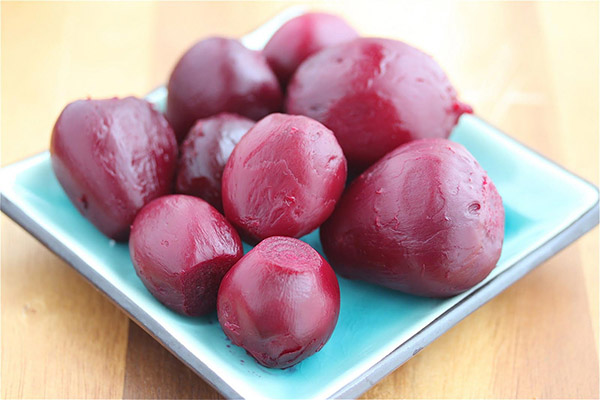
It is useful to use boiled beets for anemia, diseases associated with iodine deficiency, to improve mood and reduce symptoms of depression, normalize the liver, stomach, and intestines. During an exacerbation of chronic diseases of the digestive system, with diseases associated with an excess of iodine in the body, kidney pathologies, and diabetes, boiled beets should be excluded from the diet or their consumption should be substantially limited.
What is more useful: raw or boiled
Boiled and raw beets differ in composition insignificantly: in 100 g of boiled product - 50 kcal, in raw - 43; proteins - 2 g in boiled, 1.6 in raw, carbohydrates - 11 and 8 g, respectively. There is no fat in a cooked product, and about 0.2 ha in their raw.
Benefits of Raw Beets:
- The content of some useful substances during heat treatment is slightly reduced. Including reduced volume of vitamin C.
- The beneficial effect of nutrients is achieved faster than with a product processed at high temperature.
- Boiled beets have a higher sugar content, so it is not recommended for people with diabetes.
Benefits of boiled beets:
- B vitamins enhance their effect after baking or boiling.
- During heat treatment, possible harmful bacteria die in the fetus.
Useful properties of beetroot juice
Sugar beet juice has a number of useful properties: it has a positive effect on the state of health in diseases of the thyroid gland, removes toxins, reduces the level of "bad" cholesterol, preventing the formation of blood clots and other vascular diseases. It also increases the level of red blood cells in the blood and helps lower blood pressure. Anemia is another condition in which beet juice can relieve the course of the disease, reduce the onset of symptoms.
How to make juice
Before preparing the juice, the fruits must be washed, dried and peeled. You can use a juicer or a meat grinder.After grinding the beets, the resulting mass must be filtered, and the resulting juice should be stored in the refrigerator. Its useful properties are preserved throughout the day.
Often beetroot juice is mixed with another, because its taste is quite sharp. Unlike other freshly squeezed juices that are consumed immediately after preparation, beetroot should first be infused in a cool place for about two hours. During this time, volatile substances are removed from it, giving it an unpleasant aftertaste.
When used for therapeutic purposes, beetroot juice is introduced gradually, starting with 1/5 of the total volume. For example, for oncological diseases, it is recommended to combine beets and carrots, and for pathologies of the liver and kidneys, apples are used instead of carrots. Gradually, over 5 days, the content of beetroot juice can reach 4/5 of the volume. The course of admission of such a composition should not be less than 10 days.
The benefits of beet kvass
In addition to an extensive set of useful properties of beet kvass during the fermentation process is enriched with bacteria that prevent the development of harmful microorganisms. Thus, the beneficial effect of eating beets is enhanced.
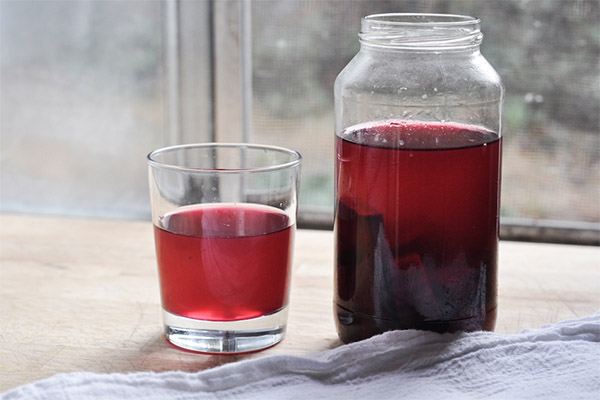
Beet kvass helps to cleanse toxins and toxins, normalizes bowel function. With hypertension, it helps to reduce pressure and reduce the frequency of seizures. It can be used for weight loss, to strengthen hair and nails, improve facial skin. Contraindications to its use are diabetes mellitus, urolithiasis, gout, allergies and acute conditions in the pathology of the gastrointestinal system.
Beet kvass can be drunk in its pure form or added to okroshka or cold soups.
A simple recipe for kvass for cooking at home: one beet fruit, peeled, cut into cubes and poured with two liters of boiled water. Place 100 g of black bread in the solution, cover the dishes loosely so that air enters the product, and stand for 3–7 days. During this period, it is necessary to remove the foam that forms on the surface of the container with kvass and not allow the temperature to rise where the semi-finished product is located. If you are in a too warm room (with a temperature of +22 degrees Celsius) pathogenic bacteria may begin to develop in kvass. Then the kvass is filtered, tightly closed with a lid and insisted for another two days. After that, it is ready for use. You can store kvass for about a month.
Are beet tops useful?
The tops of vegetables contain the same vitamins and minerals as the fruit, with individual substances found in the leaves in even greater concentration than in the root crop. Vitamin P in the tops increases the elasticity of blood vessels, prevents blood clots, internal hemorrhages, sclerosis. Vitamin U contributes to the improvement of gastritis, stomach and intestinal ulcers, and is also a substance that many associate with a slowdown in aging. Due to the content of betaine in the tops, “bad” cholesterol is eliminated from the body. Iodine, phosphorus, cobalt help improve concentration and memory.
When losing weight, you can consume salads with fresh beet leaves, which will contribute to the absorption of nutrients and accelerate metabolic processes.
Beetroot leaves used for compresses have anti-inflammatory and analgesic effects.
Before using the tops, soak it in hot water for several minutes. This will help soften her taste and reduce bitterness. In cooking, it is used in soups, pickled, salted, dried, added to the pie fillings, salads are prepared from it.
Beetroot in medicine
The beneficial substances in beets make it an important element of treatment and prophylactic regimens for various diseases. In all cases, before using root crops as medicines, you should consult your doctor. Also, before starting a course of treatment, you should make sure that there are no allergies and other adverse reactions.Most acute conditions in diseases of various body systems are a contraindication for the treatment of beets.

With diabetes
The root crop has a high glycemic index and a concentration of carbohydrates. In this regard, with diabetes, beets should be used with great care to avoid an increase in blood sugar.
The sugar content in raw beets is 2 times lower than in cooked beets, in addition, regardless of the processing method, the glycemic load index is low. Therefore, with type 1 and type 2 diabetes, it is permissible for people with digestive problems to include root crops in the diet. In addition, it has beneficial effects on blood vessels and the heart. With diabetes, organs of the cardiovascular system suffer, therefore, the use of beets is useful as a prevention of blood clots, sclerosis.
In diabetes, it is important to maintain normal weight and lose weight in the presence of extra pounds. The root crop helps the absorption of fats and accelerates the metabolism, so it is useful for the prevention of problems caused by excessive stress on organs from overweight.
Important: glycemic index of boiled beets - 65 units, raw - 30.
With pancreatitis
Pancreatitis is an inflammatory disease of the pancreas, in which enzymes affect it itself. The basic nutritional rules for this disease are to limit the amount of protein, fat, sugar, gas-stimulating foods, and salt. In the acute stage of the disease, beets are not recommended in any form. During the chronic course of the disease and as a preventive measure, regular use of beets in small amounts is useful: it cleanses the intestinal walls, acts as a natural diuretic and laxative. In this case, it is permissible to include only fruits that have undergone heat treatment in the diet, raw beets are prohibited. It is important to combine boiled beets with other products: do not season salads with fat sour cream, do not add garlic and other ingredients to the dishes that cause irritation of the digestive system membranes.
Beetroot juice can be consumed by introducing it gradually, starting with small doses, but not more than once a week. It should settle for 3 hours after preparation, it is advisable to dilute it with pumpkin or other juice.
With gastritis
Beetroot promotes digestion and assimilation of food, reduces inflammation, helps to heal the mucous membrane, prevents constipation, supports immunity. Thus, in the stage of the chronic course of the disease, the use of beets in small quantities for gastritis is allowed. In the period of exacerbation of the disease, it is better to refrain from consuming the fetus.
Excessive consumption (over 100-200 g per day) can lead to an exacerbation of the disease due to the fact that the root crop increases acidity in the stomach. Therefore, it is important not to exceed the amount of beets permitted by the attending physician and to use it in boiled or baked form. In this case, with a disease with low acid secrecy, doctors recommend that beets be included in the diet of patients with gastritis, as it helps to increase the production of gastric juice.
For the intestines
Pectin, which is rich in beets, infects putrefactive bacteria and helps remove toxins from the body. Organic acids in the root crop stimulate the production of gastric juice and intestinal motility. Fiber helps fight pathogenic bacteria in the gastrointestinal system.
During the treatment and prophylactic administration of the root crop, it is recommended to abandon the use of fatty, sweet and fried foods, which can reduce the beneficial effect of the procedures.
You should abandon the use of beets in the period of exacerbation of peptic ulcer of the intestine, which can stimulate deterioration, pain, diarrhea.
For constipation
Fiber in beetroot stimulates the intestinal muscles, nourishes its bacteria, which helps to restore peristalsis. If the cause of constipation is liver problems, it is recommended to use beetroot juice or root vegetables in raw form.Betaine in beetroot is especially effective without heat treatment. If a patient with constipation has concomitant diseases of the gastrointestinal tract, the use of a heat-treated vegetable is recommended.
It should be remembered that a reasonable dosage is observed when treating beets. Excessive or too frequent use of it can cause diarrhea.
With gout
Eat beets with gout should be with great care. It contains oxalic acid, which is involved in the processes of excretion of salts from the body. In case of violation of the urogenital system, the withdrawal of salts is difficult, they accumulate in the joints and can provoke an attack of gout - inflammation accompanied by pain.
It is permissible for gout patients to use beets only in boiled form, not more than 150 g per day. It is also allowed to drink kvass or diluted beet juice, but not more than one glass per day. Due to the diuretic effect, salts are eliminated from the body. Boron strengthens joints, betaine reduces inflammation and swelling of the joints.
With colitis
With inflammation of the intestinal walls, it is not recommended to eat raw vegetables, including beets, since they stimulate the work of the body. Excessive stress during exacerbation of the disease can cause pain and diarrhea. In the chronic stage or during the period of remission, the use of boiled beets is permissible. Begin to add it to the diet with caution, gradually bringing up to 100-200 g per day. Boiled root crop helps restore metabolic processes in the body, has a beneficial effect on the mucous membranes of the gastrointestinal tract and helps to prevent attacks of colitis.
For the liver
Betaine in the composition of the root crop has a positive effect on the liver. This substance supports the health of the body, stimulates the absorption of protein foods, and prevents obesity of the liver. Beetroot helps to accelerate the movement of bile due to the content of flavonoids in it. Thus, the main function of the liver, blood filtration, is carried out more effectively.
With hemorrhoids
The use of root vegetables helps to make the bowel movement regular, which is a key factor in the prevention and treatment of hemorrhoids. Compresses with beetroot juice help with acute inflammation.
With cholecystitis
With this disease, inflammation of the walls of the gallbladder is observed, which leads to a violation of the outflow of bile, complicates the absorption of fats, affects stool. On the first day of an acute attack, only drinking warm water or weak tea with breadcrumbs is allowed. After weakening the symptoms of exacerbation, restrictions are introduced into the diet: fatty foods, heavy meals, alcohol and foods that irritate the digestive system are prohibited. Such products, including raw beets, which affect the body quite intensively.
Boiled, baked beets and juice from it are part of the diet for cholecystitis, since they reduce the frequency of attacks, contribute to the normalization of metabolic processes in the body. To prevent exacerbation and help in the treatment, it is enough to consume about 100 g of beet products daily.
With anemia
Iron and magnesium in beets make it an important element in the treatment of anemia. Regular consumption of beets helps to improve blood counts, increase hemoglobin and increase the concentration of red blood cells, normalize coagulation (makes it less viscous), and cleanse blood vessels.
Beet-based traditional medicine recipes
Beetroot is useful as a treatment and prevention of diseases of the throat, nose and upper respiratory tract:
- With angina, honey is mixed with beetroot juice in a ratio of 1: 2 and consumed on an empty stomach 2-3 times a day.This helps to reduce sore throat, the active substances fight the causative agents of the disease and can reduce the time of its course.
- Beetroot juice is instilled into the nose with a runny nose to fight viruses and bacteria. For the procedure, freshly squeezed juice is defended in the refrigerator for 4 hours, then heated to a comfortable temperature, diluted with water in a ratio of 1 part juice to 3 parts water. Use the product 3-4 times a day for 3-5 drops in a course of at least 5 days. For children under three years of age, the dosage is reduced to 1 drop. Beetroot juice prepared as described above is also used to treat ear pain.
- With anemia, low hemoglobin and other problems of the circulatory system, a prophylactic course for beetroot juice can be taken: beets, radishes and carrots are passed in equal parts through a juicer or meat grinder. The mixture is taken 15 minutes before a meal, 2 tablespoons. To achieve a stable result and increase hemoglobin, the course should be carried out for at least one month.
- All the beneficial properties of beets for the health of the male genitourinary system can be obtained in the form of freshly squeezed juice. Juice from carrots, beets, cucumbers, sweet peppers is mixed in equal proportions and take 0.5 cups three times a day for a month. If necessary, the course can be repeated after a break of 10 days.
- Beet tops are used as a local anesthetic and anti-inflammatory agent. For skin diseases, including lichen, eczema, dermatitis, compresses from boiled beet leaves, crushed and mixed with honey in a ratio of 1: 1 can be used. It is important to use the tool in the absence of open wounds with discharge, only on healed areas.
- When mastitis, mashed leaves are applied to the densified areas of the body for half an hour. The procedure is repeated daily as part of complex therapy.
- In case of headache, mashed leaves wrapped in gauze are applied to the temples or forehead for 15-20 minutes.
- Corns or cracks in the legs are smeared with juice from the tops. The legs are wrapped with a bandage on top and the composition is left overnight.
Beets in cosmetology
Beetroot is a common ingredient in face masks, hair products. To prepare cosmetics use both tops and root crops.
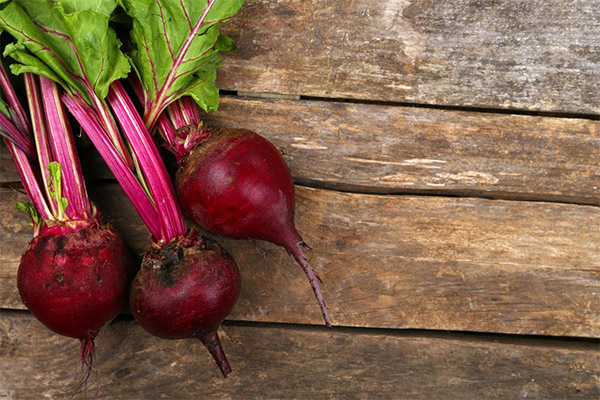
For face
In order to reduce oily sheen, improve complexion, moisturize and refresh the skin, boiled beet masks are used. For their manufacture, the fruits are boiled, peeled, rubbed on a fine grater and excess juice is removed. The exposure time should not exceed 20 minutes, after the procedure, the skin should be cleaned of the product and apply a moisturizer on it. Various additional components will help to achieve the desired effect for various problems:
- To give the skin an even matte shade, one teaspoon of camphor alcohol is added to grated beets. This mask is used for two weeks every other day.
- To moisturize the skin, add 200 ml of milk, 100 ml of tincture of St. John's wort and 2 teaspoons of aloe juice to 200 g of grated boiled beets.
Washing with beetroot decoction with the addition of 5% apple cider vinegar (1 teaspoon in 2 cups of decoction) will help reduce rashes on the skin of the face.
A face mask from mashed crushed beet leaves helps to relieve irritation, eliminate rashes, and accelerate the healing of injuries.
For hair
Beetroot juice staining is a way to give the hair a healthy shine, strengthen it, and reduce inflammation of the scalp. This method is suitable for those who are allergic to chemical dyes, as well as people who are contraindicated with the use of non-natural means, for example, pregnant and lactating women.
- To prepare the dye, you need a glass of beetroot juice, half a pack of henna powder and 3 tablespoons of lemon juice. The mixture is applied to the roots, then over the entire length of the hair and left for 15-30 minutes. If you need a dark shade, you can add basma to the mixture.
- The addition of carrot juice or coconut oil will help improve the condition of the hair, give them strength.
- Women with blond hair should keep in mind that such coloring gives a red tint to curls. More often this cosmetic procedure is used by brown-haired women and brunettes.
- Like all natural dyes, beet juice in combination with henna has a visible effect for no more than two weeks. Then the procedure should be repeated.
A mask of grated boiled beets, applied to the hair roots, helps in the fight against dandruff. To achieve a stable positive result, the procedure should be repeated 2-3 times a week for a month.
Harm and contraindications
There are a number of diseases in which the use of beets should be limited:
- With hypotension and a tendency to lower pressure, the root crop can provoke a strong decrease in pressure.
- With urolithiasis and gout, beets can cause deterioration, make it harder to remove salts from the body, and cause inflammation in the joints.
- During an exacerbation of diseases of the gastrointestinal tract, the use of fresh beets should be discarded, the boiled fruit and its juice can be used with great care.
- In diabetes, the number of root crops consumed daily should be limited to 100-200 g due to the high sugar content in them.
- When using beets for a laxative effect, one should remember about a possible overdose and related diarrhea.
- Beets can cause an allergic reaction, before starting to use it for therapeutic and prophylactic purposes, you need to conduct a sensitivity test.
Beet harvesting and storage
Root crops protrude above the surface of the earth, so beet harvesting should be planned for the period before the first frost, in order to avoid damage to the fruit. Some varieties ripen in July, but most often the harvest time is August or early September. The main sign of fruit readiness for harvest is dried and yellowed leaves. The size of the root crop should be about 10 cm in diameter.
During harvesting, the beets are dug up and carefully removed from the ground. Then it is shaken off from the remains of the earth and the leaves are cut off. The remainder of the tops should be no more than 2 cm. After the slices harden and the fruits dry out from excess moisture, the beets can be removed for storage.
Fruits without scratches and cracks can be stored for up to 8 months. Humidity in the room should not be more than 85%, temperature - about +3 degrees Celsius. Fruits can be stored in bags covered with sawdust. Another option is crates sprinkled with peat or sand. The neighborhood of beets with potatoes has a beneficial effect on the condition of both vegetables, they retain their properties longer.
Is it possible to freeze
Beets can be frozen raw and cooked. The most convenient way is to boil the fruits, chop to the desired size (grate or chop), put into containers or portioned size packets and put in the freezer. Repeated freezing after thawing is not recommended. Boiled beets are stored in the refrigerator at a temperature of 0 to +6 degrees for no more than two days, in a frozen state at a temperature of about -18 it can be kept for up to one year.
What can be cooked from beets: recipes
A variety of beetroot dishes are used in the cuisine of many peoples of the world and Russia. Most often, salads and first dishes are prepared from it, but there are many other simple ways to prepare it, which will help to heal the body and add variety to the usual diet.
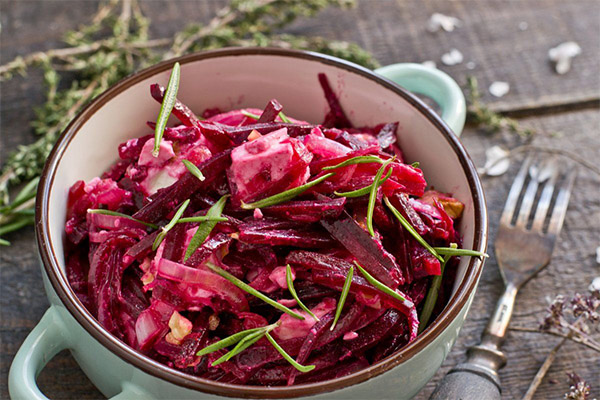
Salad
For salads, raw or boiled beets are used.
- Fresh beets go well with grated apples, carrots, radishes and other vegetables. In order to make the salad more nutritious, you can add nuts, raisins, prunes, soft cheese or lean meat to it. It is best to season such salads with vegetable oil or sour cream.
- Boiled beets can be an independent dish, just grate it, add salt and olive oil to it. Adding to it green onions, parsley, cilantro will make the dish more flavorful. Nuts, meat, prunes or garlic will give salads spiciness, sweetness or other tastes.
In order that the bright fruit does not stain other components of the salad with its juice, before adding beets to other ingredients, it should be mixed with vegetable oil.
Caviar
To prepare beetroot caviar, the boiled vegetable is rubbed, mixed with salt, garlic, pepper and simmer for half an hour. It is possible to cook caviar from raw root vegetables with the addition of various vegetables.
For example, you can mix raw grated beets with carrots and tomatoes, minced in a meat grinder, in equal proportions. Then add three tablespoons of finely chopped onions. Stir the vegetables, add salt, pepper, parsley and simmer for two hours. A few minutes before the end of cooking add sugar, vinegar. After that, the caviar is ready for consumption or preservation.
Cutlets
For the preparation of original vegetable cutlets, 300 g of grated boiled beets will be required. To it add 50 g of butter, one egg and semolina for consistency, as well as salt and pepper to taste. Cutlets from the resulting mixture are crushed in breadcrumbs or flour and stewed for 40 minutes. Grated boiled carrots can be added to beets.
Phali
For cooking, you will need such components: one boiled beetroot, 2 cloves of garlic, 200 g of walnuts, cilantro, parsley, green onion, 5% red vinegar. Nuts are crushed in a blender with herbs. Then they add boiled beets, cut into pieces, and process everything into a medium-grained mixture. Vinegar, garlic, salt and other spices to taste are added to the resulting mass. After mixing, form balls and serve them to the table.
Mashed potatoes
Using a blender, chopped boiled beets (3 pieces) mixed with olive oil, 2 cloves of garlic, salt and half a glass of low-fat yogurt. The resulting mixture is heated, not bringing to a boil, and stewed for 5-10 minutes.
Carpaccio
The first step is to prepare the marinade. To do this, mix half a glass of olive oil, 2 tablespoons of balsamic vinegar and 2 tablespoons of honey. Then boiled beets are cut into thin plates and marinated for at least two hours. After this, a cream is prepared: mascarpone or other soft unsalted cheese (200 g), 100 g sour cream, 10 g citrus zest and 5 g coriander are mixed. Slices of beets spread on a plate, sprinkled with herbs (arugula or other, to taste), spread cream on top, sprinkled with pine nuts and finely chopped green onions.
Kvass
To prepare a traditional Russian drink you will need:
- 100 g sugar
- three liters of water;
- salt to taste;
- 1.5 kg of table beets.
Wash raw beets, peel, cut into slices. Then place it in warm water, cover with sugar and salt and leave for a week in a warm place. After 6-8 days, kvass will be ready.
In the preparation of kvass with the addition of sugar, additional fermentation processes are stimulated, as a result of which ethanol is formed in the composition of the drink. This should be borne in mind when using kvass before driving and performing work that requires concentration.
The salt in the composition of kvass gives the drink an additional shade of taste, and also acts as a preservative, preventing the development of bacteria during fermentation. It also helps to extract natural sugars from beets. Therefore, kvass made without added sugar is also quite sweet.
To speed up the fermentation, you can add whey from sour milk or brown bread to the water. It is also acceptable to use raisins, dried apricots, dried ginger and other ingredients to enrich the taste and aroma.
Borscht
There are many options for cooking borsch, they vary depending on the region, the tastes of the hostess and the available ingredients. Simple and quick recipe:
- From meat broth remove meat, bay leaf and other seasonings. In a broth add 3 cubed potatoes, 200 g of grated cabbage and boil them for about 10 minutes.
- Carrots (1 piece) and onions (1 piece) are finely chopped and fried in a pan for 5-10 minutes.Then, add 1 beetroot, grated on a medium grater, tomato paste (3 tablespoons) or 2 tomatoes, passed through a meat grinder, to the frying. Stew the mixture for about 10 minutes.
- Fry, potatoes with cabbage, pre-cooked chopped meat, mix, add fresh herbs, salt, pepper to taste and cook for 10 minutes. Then the borsch is left for one and a half to two hours and after that it is served to the table.
Sauce
In a small bucket, half a glass of dry white wine is heated, then 1 diced beetroot is added to it, then 150 g of meat broth is introduced there. After 15 minutes, salt and pepper are added to the mixture. After that, the sauce is cooled and processed with a blender until a homogeneous mass is obtained. Before completing the preparation, 1 tablespoon of sour cream is introduced into it, you can add sugar or other spices to taste.
Beet Chips
Chips made from beet slices are a hearty and healthy snack or an original snack. To prepare them, you need 2-3 fruits and seasonings to taste. Cut the beets into thin plates, place on a baking sheet and place in an oven heated to 200 degrees for 15–20 minutes. After drying, chips can be sprinkled with salt, sesame, pepper or other seasonings. To give them a flavor, you can add olive oil before serving.
How to pickle
Pickled beets, prepared for the winter, can be useful for making soups, salads or as side dishes for hot dishes. To prepare in a 1.5 liter jar you will need:
- beets - 1 kg;
- 6% vinegar - 3 tablespoons;
- water - 1.5 liters;
- sugar - 150 g;
- salt - 30 g;
- allspice - 5 peas;
- cloves - 5 pieces.
Beets should be cooked, then cut into long strips or grated on a coarse grater. To prepare the pouring, boil sugar, salt, pepper and cloves for 5 minutes. Wash and sterilize the workpiece. Then put the beets, seasoning and vinegar in it. Cover the dishes with beets with a lid, sterilize for 10 minutes. Immediately after this, close the cans tightly and leave in a darkened cool place.
How to cook
For cooking, fruits no larger than 10 cm in diameter, with thin skin and without external damage, are best suited. Before cooking, beets should be thoroughly washed, cut the tail and tops.
- Beets are cooked on the stove for about two hours at low heat. It is important that the water fully covers the fruits. You can’t salt water, it will make the vegetable firmer. To maintain a bright red color, you can add 1-2 g of citric acid or half a tablespoon of lemon juice per liter of water.
- To speed up the process, you can add 3 tablespoons of vegetable oil to the water and cook the beets on high heat for about 40 minutes. Then, beets should be placed under running cold water for another 20 minutes. The temperature difference helps to soften the fetus.
- In a slow cooker, beets can be cooked in the “steamed” mode, placed on a wire rack, or “stewed”. Cooking time is determined depending on the model of technology and usually is about an hour. You can also use the baking mode. To do this, the beets are wrapped in foil greased with vegetable oil, placed in a multicooker bowl and left for one hour.
How to bake
Roasting is a convenient way for cases when you need to cook a large volume of beets, for example, for several salads. It is necessary to preheat the oven to 180-200 degrees. Wash the beets, remove excess moisture from it. Then wrap each fruit in a foil greased with vegetable oil. Bake beets for about an hour.
Is it possible to eat raw beets every day
In the absence of contraindications and subject to a reasonable dosage, it is permissible to eat salads and appetizers from raw beets daily. A safe norm is considered to be about 200 g per day, however, if undesirable reactions occur, reduce the portion size of the raw fruit or use it less often, alternating with boiled product or juice.
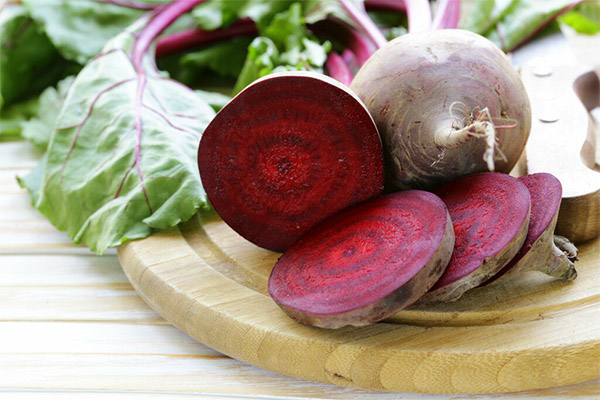
Can I eat at night and on an empty stomach
The use of root vegetables before meals helps to enhance metabolism, better absorption of vitamins and minerals, improve appetite. The use of beets for therapeutic purposes is always performed on an empty stomach.
Beets at bedtime help the absorption of food eaten during the day and the burning of fat.Boiled root vegetable salad with olive oil, eaten for dinner, will give a feeling of satiety, will help the gastrointestinal tract and cleanse the body of toxins.
Is it possible to give beets to animals
Beet feed is a nutritious and healthy product for cattle. Vitamin-rich root crops can also be offered to other pets, but caution should be exercised.
- Dogs can be offered a small amount of raw or boiled beets several times a week. It should be remembered that it often causes allergies in pets, so you should start with a minimum amount. Also in dogs with light hair, it can cause a change in color, give them a red tint.
- Cats can be offered boiled beets or beetroot juice as a prophylaxis for urolithiasis or digestive problems. Beets are often part of the ready-made feed for cats.
- Hamsters often suffer from diarrhea and allergies, even with minimal amounts of beets eaten. It is better not to treat them with root vegetables or to do this rarely.
- Guinea pigs may receive raw, boiled, or dried beets. It saturates their body with vitamins, is the prevention of many diseases.
- It is advisable for rabbits to offer fodder beets, but to introduce it into the diet gradually, starting from 25 g per day. It is good for their health and growth, but can also cause allergies and diarrhea.
- Budgerigars are happy to eat raw beets. It is very beneficial for their health and should be included in their diet on a regular basis.
- Chickens should also receive a supplement in the form of chopped raw or boiled beets in their diet. However, the number of root vegetables should be limited in order to avoid digestive problems.
Why after beetroot urine turns red
The beet contains betacyanins, which are natural coloring pigments. Depending on the amount of fetus eaten and on the concentration of the dye in it, urine can acquire a shade from pink to red. Betacyanin is considered harmless to health, it is widely used in the food industry.
The more liquid a person drinks during the day, the lower the concentration of the dye in the cells of the body, the less saturated the color of the secretions. Beet variety is also important, some varieties contain a minimum amount of dye. Storage conditions are also important. Betacyanin decomposes under the influence of sunlight. Beets stored on the street will be colored less than those stored in the dark. Baked or steamed beets stain the urine more strongly than the one that was cooked, since most of the dye in it passes into a decoction.
The increased acidity of the stomach interferes with the breakdown of the coloring pigment. If you use beets on an empty stomach, the color of urine will not change. If you combine root vegetables with lemon juice, onions, and other products with a high acid content, the concentration of pigment in the urine will be high, its color will be bright.
Interesting facts about beets
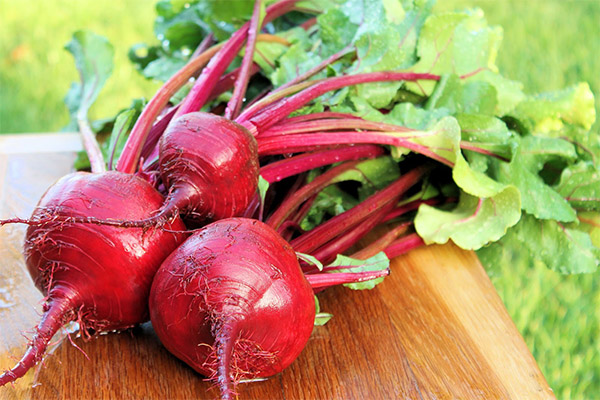
- In ancient Rome they used beet tops soaked in vinegar or wine. Mention that root vegetables are suitable for eating came much later than information about pickled tops.
- In ancient Rome, beets, along with several other vegetables, were sacrificed to the god Apollo. This fruit was considered to bring strength and youth.
- Beetroot begins to gain popularity in Russia both among gardeners and among culinary specialists. Its feature is that it does not have a root crop habitual for a plant of its species. Only leaves are consumed. The plant has a bright tops, sometimes it is grown for decorative purposes.
«Important: all information on the site is provided exclusively in fact-finding purposes. Before applying any recommendations, consult with a profile specialist. Neither the editors nor the authors are liable for any possible harm caused materials. "

